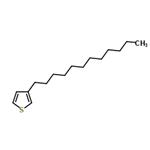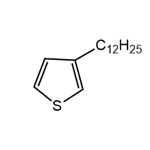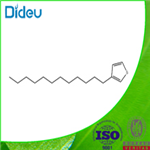Preparation
3-Dodecylthiophene can be prepared from 3-bromothiophene and halogenated hydrocarbons in one step.
Steps: Under N2 atmosphere, slowly add 1-bromododecane (28.75g, 26.9 mL) to a 250mL three-necked flask containing a mixture of magnesium chips (3.28g, 0.135mol), anhydrous THF (30mL) and a small amount of iodine. mL, 0.13 mol) in dry THF (45 mL). After the mixture was refluxed at 70 °C for 2 hours, the system was cooled to room temperature with ice water, Ni(dppp)Cl2 (0.54 g, 1.00 mmol) was added first, and then 3-bromothiophene (16.31 g, 0.10 mol) was added slowly. Anhydrous THF (40 mL) solution. The mixed solution was stirred at room temperature overnight, and cold aqueous HCl (1.50 mol/L) was added to quench the reaction. The crude product was extracted with dichloromethane, dried over anhydrous magnesium sulfate, and further purified by column separation purification (n-hexane as eluent), resulting in a clear liquid (22.18 g, yield=88%).
General Description
3-Dodecylthiophene (3-DT) is a conjugating monomer that can be used as an active layer on semiconductors. It has good electronic properties and can be used in the development of p-type semiconducting polymers. It is mainly used in the formation of poly(3-dodecylthiophene) (P3DT) through electrochemical polymerization. P3DT can further be utilized for a variety of organic electronic based applications.




